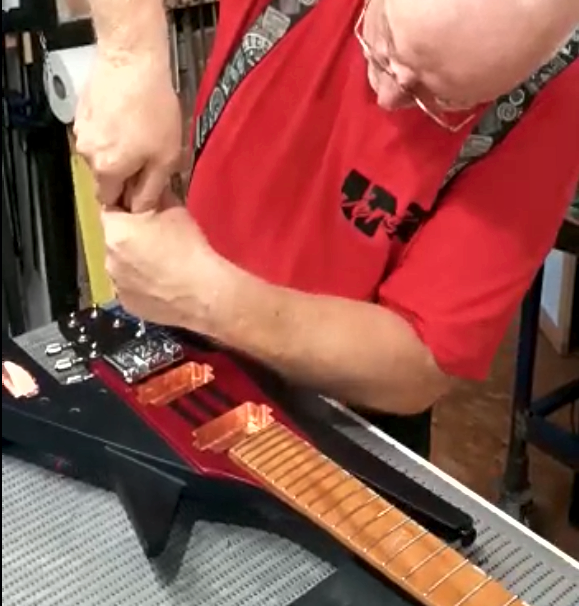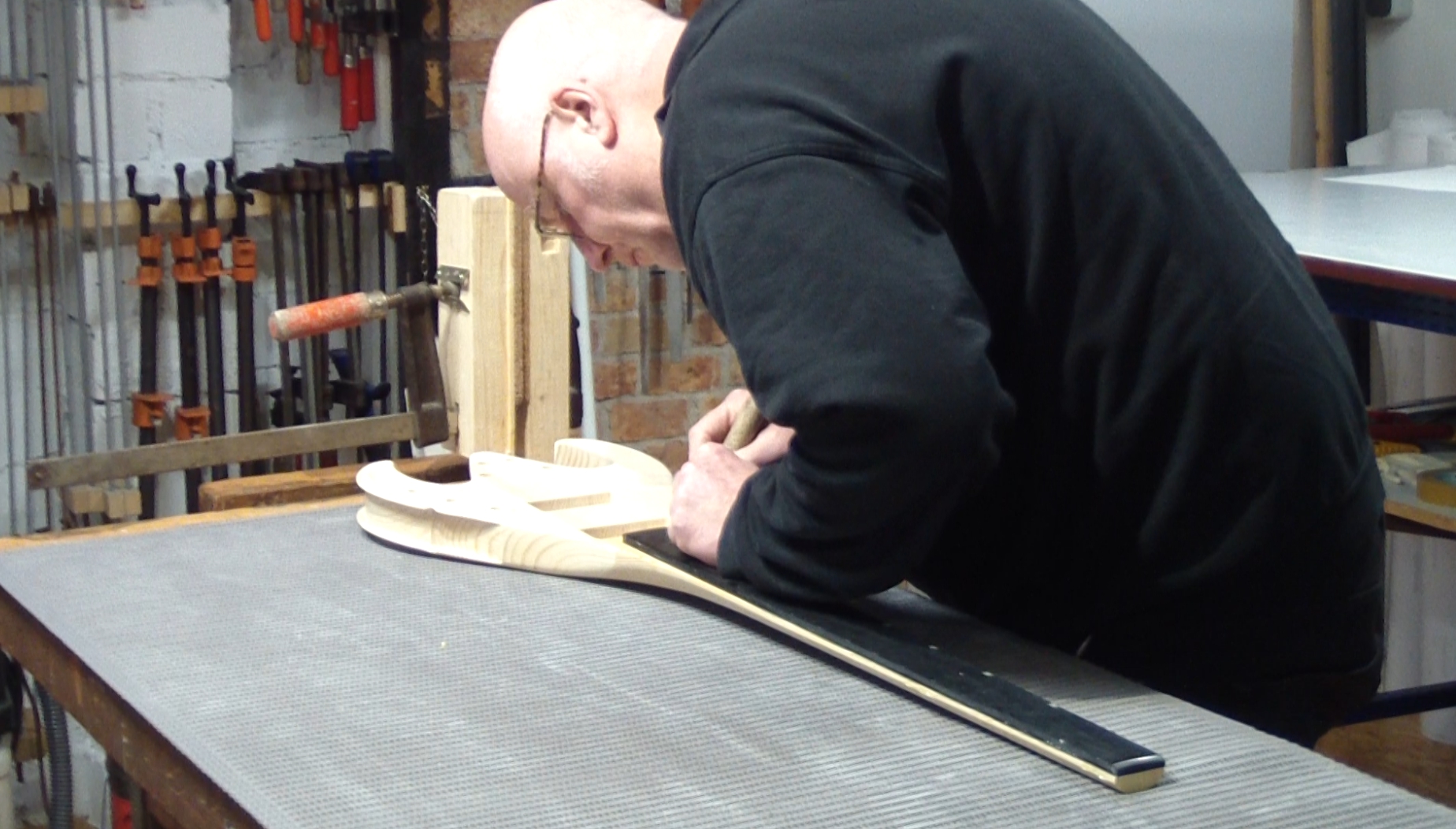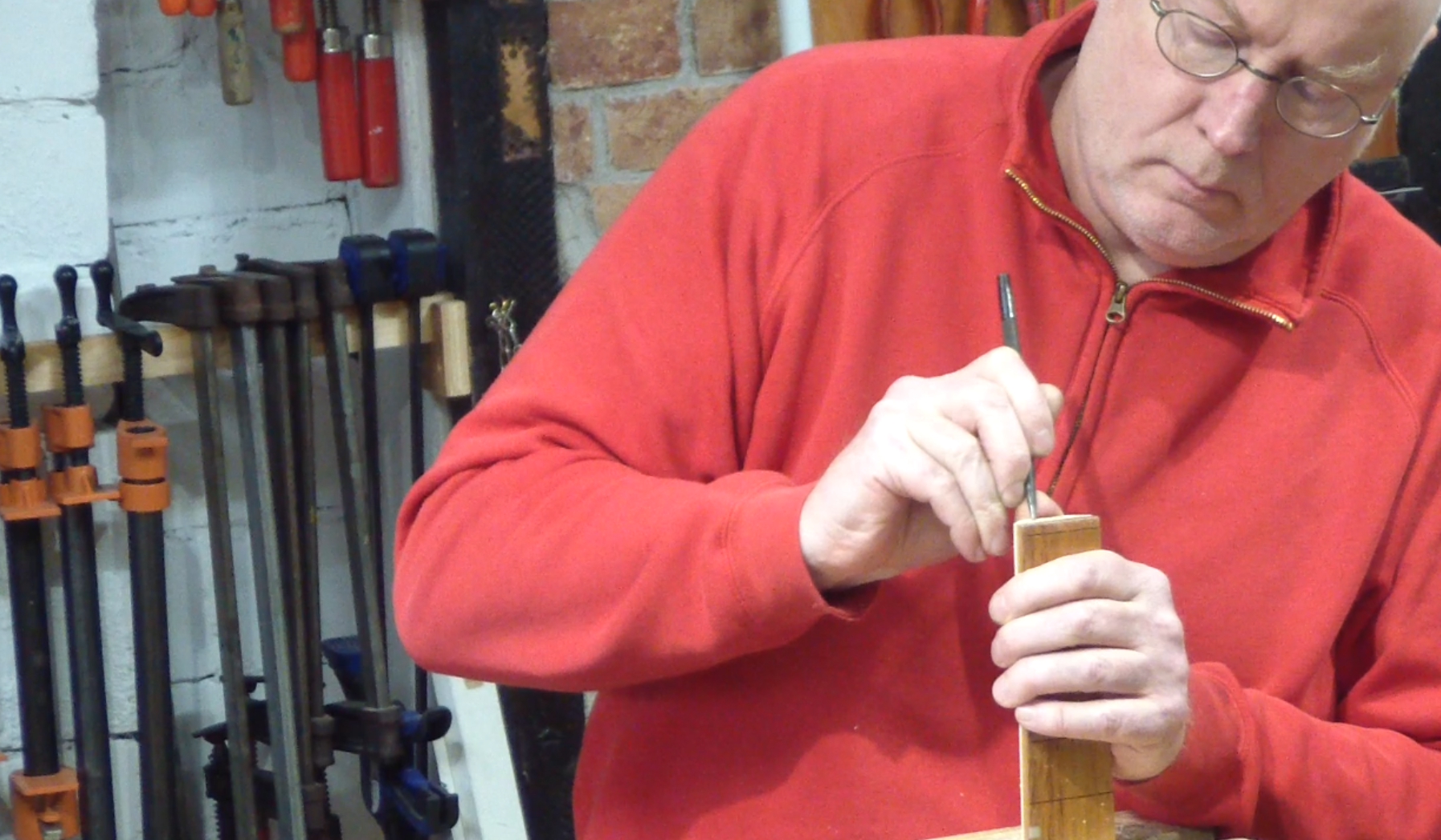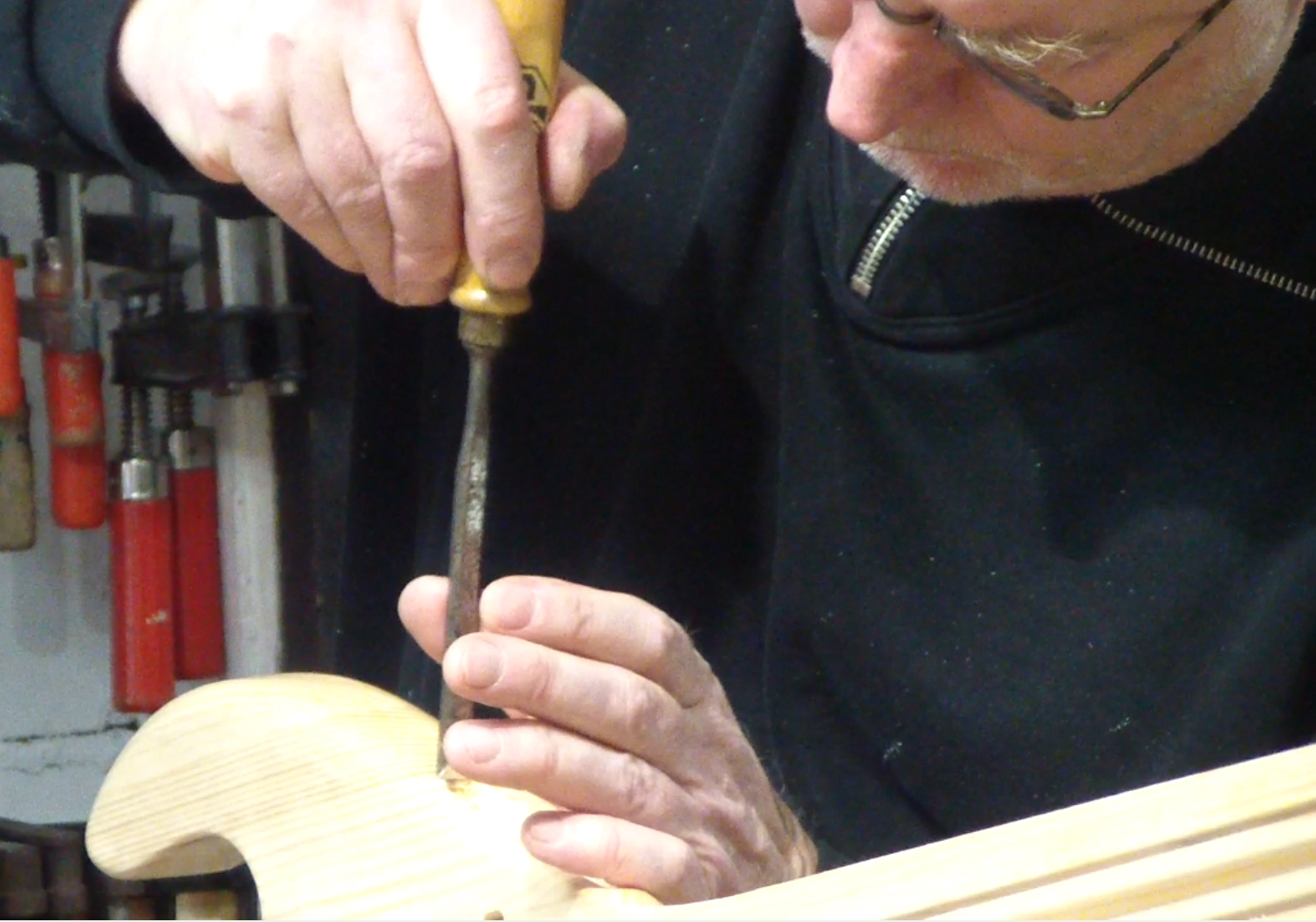My name is Martin Epding and Inverse Guitars is a matter of heart, art and craftsmanship. In my childhood I learned to work with different materials, preferably wood, by building models. In my youth, electronics came into play, especially synthesizers. At the age of 15 I built two synthesizers and made music with my friends. At the age of 17 I discovered punk, bought my first bass and in the rehearsal room of our band it was all about loud and fast. The bass was very heavy and I started thinking about how to improve the instrument.
In 1982 the first draft of a new bass was created on the drawing board at home. Full of enthusiasm that I had created something revolutionary, the headless bass, I visited the Frankfurt Music Fair in 1983. At one booth I saw an exhibitor whose booth was completely empty except for two chairs, an amplifier and a paddle-shaped headless instrument. The man was demonstrating the mechanical stability of the bass by sitting on it between the chairs. That was Ned Steinberger and his bass. I realised that the headless idea wasn't entirely mine. In terms of design, I couldn't get anything out of the instrument and realised that Steinberger was relying on his own proprietary hardware, such as tuning machines and special double-ballend strings. The following year, Steinberger's stand literally exploded, his success was immense, many musicians were using his bass. I decided to let the headless idea rest for a while.
I decided to study electrical engineering, did an apprenticeship as a carpenter and spent the rest of my life studying airbrush art and advertising technology. However, music has always been a part of my life and I learned (or rather tried) to play the cello and the guitar.
To this day I find headless instruments aesthetically very unsatisfactory, hardly any instrument manages to finish the neck at the head end satisfactorily. The special tuning mechanism for headless instruments does not convince me either. A few years ago I thought it was time to put my designs for stringed instruments into practice. The first instrument based on the plans I forged as a young adult was successfully built entirely by hand in my home workshop.
Fascinated by the possibilities offered by modern computer and CNC technology, I began to create my designs in CAD programs. I built a CNC milling machine, bought a 3D printer and started making prototypes.
As the design process progressed, I kept coming up with new ideas, and today I have more than ten different models and designs, and i hope I never run out of ideas.
My drive is to redefine the guitar from an ergonomic and aesthetic point of view. I try to use native, local woods for my instruments, especially European spruce for its strength, weight and acoustic qualities. I consider each of my instruments to be a unique piece of craftsmanship and try to build joyful tools for making music.
I try to use local woods for my instruments, especially European spruce for its strength, weight and acoustic qualities, although I do have a stock of mahogany. As my instruments are completely handmade, please feel free to ask for individual wood combinations, pickup configurations, etc. I welcome enquiries about customising the instrument in terms of finish, woods, hardware, scales, number of strings, string spacing or whatever you wish.
I make as many parts of my instruments as possible in my workshop:
- the body and neck
- the fingerboard
- the varnish,
- the active electronics,
- the pat. headstock,
- the base plate of the pat. headstock,
- the knobs,
- the brass bridges,
- the control knobs of the tuning machines,
- the pickups
Besides building guitars I repair or restore your favourite guitar. I do refretting, i paint your guitar or i set the action of your guitar or....
I hope you like my funny poems describing my instruments ;)
Mein Name ist Martin Epding und Inverse Guitars ist eine Angelegenheit meines Herzens, meiner Kunst und meines Handwerks. In meiner Kindheit habe ich durch das Bauen von Modellen gelernt, mit verschiedenen Materialien zu arbeiten, vorzugsweise mit Holz. Später kam dann die Elektronik ins Spiel, insbesondere Synthesizer. Mit 15 baute ich zwei Synthesizer und machte mit meinen Freunden Musik; zwei Jahre später entdeckte ich den Punk, kaufte mir meinen ersten Bass und da ging es nur um “laut und schnell". Das Gewicht des Instrumentes machte dies jedoch sehr erschwerlich und ich begann darüber nachzudenken, wie man das Instrument verbessern könnte.
1982 entstand zu Hause auf dem Reißbrett der erste Entwurf eines neuen Basses. Voller Begeisterung darüber, dass ich etwas Revolutionäres geschaffen hatte, den Headless Bass, besuchte ich 1983 die Frankfurter Musikmesse. An einem Stand sah ich einen Aussteller, dessen Stand bis auf zwei Stühle, einen Verstärker und ein paddelförmiges, kopfloses Instrument völlig leer war. Der Mann demonstrierte die mechanische Stabilität des Basses, indem er sich zwischen den Stühlen auf ihn setzte. Das war Ned Steinberger und sein Bass. Mir wurde klar, dass die headless Idee nicht nur mich umtrieb. Was das Design angeht, konnte ich dem Instrument nichts abgewinnen und erkannte, dass Steinberger auf seine eigenen Techniken vertraute. Der immense Erfolg Steinbergers führte dazu, meine Idee eine Weile ruhen zu lassen.
Nach meinem Studium der Elektrotechnik und der Lehre zum Schreiner verbrachte ich mein weiteres Lebens damit, mich mit der Kunst des Airbrushens und der Werbetechnik auseinander zu setzen, doch trotz allem blieb die Musik immer ein Teil von mir und ich lernte (oder besser gesagt versuchte) Gitarre und Cello zu spielen.
Bis heute finde ich die gängigen headless Instrumente ästhetisch sehr unbefriedigend, denn kaum ein Instrument schafft es, den Hals am Kopfende zufriedenstellend abzuschließen. Auch die speziellen Stimmmechaniken für Headless Instrumente überzeugen mich nicht. Also kam schließlich die Zeit, wo ich meine Entwürfe für Instrumente endlich in die Praxis umsetzen wollte. Das erste Instrument, das auf den Plänen von vor 40 Jahren basiert, entstand in reiner Handarbeit in meiner Heimwerkstatt.
Fasziniert von den Möglichkeiten, die moderne Computer-Technologie bietet, begann ich, meine Entwürfe am Rechner zu erstellen. Ich baute eine Fräsmaschine, kaufte einen 3D-Drucker und begann mit der Herstellung von Prototypen. Im Laufe des Designprozesses kamen mir immer neue Ideen, von denen ich bislang zehn verschiedene realisiert habe, und ich hoffe, dass mir die Ideen sobald nicht ausgehen.
Mein Antrieb ist es die Gitarre unter ergonomischen und ästhetischen Gesichtspunkten neu zu definieren. Ich versuche einheimische Hölzer für meine Instrumente zu verwenden, vor allem europäische Fichte wegen ihrer Stärke, ihres Gewichts und ihrer akustischen Qualitäten. Ich betrachte jedes meiner Instrumente als ein kusthandwerkliches Einzelstück, gebaut als optimales Werkzeug für Kreative.
Da meine Instrumente komplett handgefertigt sind, können Sie mich gerne nach individuellen Holzkombinationen, Tonabnehmerkonfigurationen usw. fragen. Ich freue mich über Anfragen zur individuellen Gestaltung des Instruments in Bezug auf Lackierung, Hölzer, Hardware, Mensuren, Anzahl der Saiten, Saitenabstand oder was immer Sie wünschen.
Ich fertige möglichst viele Teilaspekte meiner Instrumente selbst in meiner Werkstatt:
- den Korpus mit Hals,
- das Griffbrett,
- die Lackierung,
- die aktive Elektronik,
- die Spitze,
- die Grundplatte der Spitze,
- die Knöpfe,
- die Brücken aus Messing,
- die Bedienknöpfe der Stimmmechaniken,
- die Tonabnehmer
Neben dem Bau von Instrumenten repariere oder restauriere ich auch gerne eure Lieblingsgitarren und Bässe. Ich lackiere, bundiere, stelle die Saitenlage optimal ein oder ... fragt einfach mal:Inverse guitars / Martin Epding



